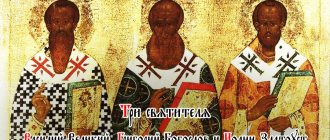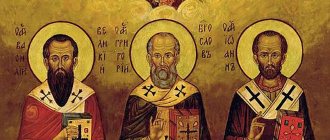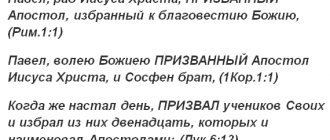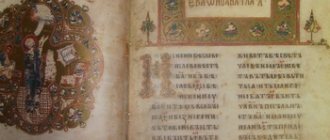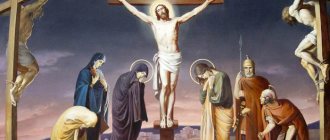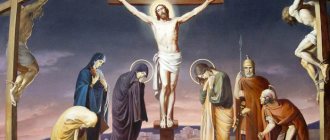He rightfully owns the words of one of the most outstanding prophets who ever lived on Earth. The greatest minds of mankind have been racking their brains over his Revelation, or Apocalypse, for more than a millennium, but so far they have not advanced a single step in the solution. He was Christ’s beloved disciple, and only to him did the Savior reveal a great secret: he allowed him to look into the future... You, of course, guessed that this was John the Theologian.
Fate was favorable to him - almost all the apostles ended their lives with martyrdom, but Christ prepared a different fate for John: “... I want him to remain until I come.”
The Path of the Prophet John the Theologian
John was born in Galilee, one of the districts of Palestine. Together with his father Zebedee and his brother Jacob (also a future apostle), he fished. A special spiritual atmosphere reigned in their family. The leaders, and especially Salome, the mother of John, were very religious people. According to one version, Salome was the sister of the Blessed Virgin Mary herself, that is (if you believe this hypothesis) Jesus Christ and John were cousins. Many researchers explain the special attitude of Christ towards John precisely by this fact.
After all, the latter was present at almost all the most important events in the life of the Savior: during his transfiguration, during prayer in Gethsemane. It was John who Jesus asked before his death to take care of his mother. In the last minutes of his earthly life, the Son of God, looking at Mary and his beloved disciple standing at the cross, quietly said: “Woman, behold your son! Behold your mother! John fulfilled the will of his teacher exactly.
Those who deny the relationship between the prophet and Christ argue that the meeting of the son of Zebedee with Jesus took place in Bethabara on the Jordan River, and John the Baptist introduced them. “Behold the Lamb of God, who takes away the sins of the world,” said the Baptist. Christ made a stunning impression on John. He greedily hung on his every word and, together with Andrew, a childhood friend and future apostle, followed the Messiah. “Having come to Christ and listened to Him for one evening, they no longer returned to John (at first it was the Baptist who was the teacher of the Theologian - E.S.), but they so surrendered to Christ that they accepted the ministry of John and themselves began to preach about Christ,” - John Chrysostom testified.
Beloved Disciple of Christ
A person unfamiliar with church tradition, when first seeing Leonardo da Vinci’s fresco “The Last Supper,” may be a little confused: in the famous painting, at the right hand of Christ, a figure with a youthful face and long hair is depicted. An inexperienced viewer almost always has the idea that a woman is sitting next to Jesus. There is even a whole story circulating on the Internet that this is Mary Magdalene, who was allegedly the wife of the Preacher from Galilee. But everything is much simpler. The long-haired young man is none other than John Zebedee, Christ's beloved disciple.
At the time of the Gospel events, he had barely reached adulthood, which is why artists very often depict this apostle with effeminate features. However, behind the young appearance hid a very lively, inquisitive mind and fiery faith. Knowing this, the Lord almost immediately after going out to preach called John to follow Him, because he saw in him enormous spiritual potential. And indeed, it was the youngest disciple of Jesus who was later to become one of the pillars of Christianity, an exponent of the most important truths of the Gospel teaching. It is noteworthy that among the saints of the Eastern Church, only three people have the title of theologian, and the first among them is John.
According to legend, John's mother was Salome, the daughter of Joseph the Betrothed from his first marriage. We do not know for certain how Christ’s relationship with his relatives developed before the beginning of His preaching. It is only known that when the Lord began His public ministry, the brothers and sisters perceived it differently: some with surprise, some with sympathy, some with coolness.
Salome was one of those who warmly treated her Brother, and subsequently followed Him. But that was a little later, and before the Savior went out to preach, she lived with her husband and children in Bethsaida, a small fishing village near Lake Galilee. John was raised by his parents to be a believer and a hardworking boy. The family was quite wealthy, but this wealth came through hard work: every night Zebedee and his sons caught fish, selling it in the morning to merchants at the local market - what is called wholesale. During one of these activities - mending nets and sorting the catch - Jesus one day found His elderly son-in-law. His children John and Jacob worked next to their father. Christ told them:
- Follow Me, and I will make you fishers of the souls of men...
The young people left everything - their trade, their home, their parents - and followed Christ. This was already a feat on their part, because it is often very difficult for people to see in their relative something more than just a relative. Surely they were accustomed to the fact that their step-Uncle was engaged in carpentry and fed His lonely Mother. And then suddenly - such changes. But the brothers had warm hearts who told them: “Go!” And the future apostles, trusting this call, followed the Teacher.
True, one of the brothers, John, realized even earlier that Jesus was the Messiah. A few months before his calling, he went to the Jordan to listen to another preacher - John the Baptist. One day, the son of Zebedee happened to be present at the meeting of the Baptist and Christ. When the Savior left, the Forerunner turned to his followers and said: “Here is He - the Lamb of God, who will take away the sins of the whole world.” After such words, young John began to look more and more often in the direction of Christ, and when He finally called him, without hesitation he became a disciple of the Lord.
Very soon the Savior began to trust John with his most secret thoughts about the Kingdom of Heaven. A young man—almost a child—John at that time was the only one of the apostles who fully understood and accepted the Teacher’s speeches. The other disciples were no less capable, but their minds were still clouded by the experiences they had gained before their calling. And the soul of young John, in fact, was a blank sheet of paper on which the Lord wrote the most important words. Then, when almost everyone who saw the Lord in the flesh has departed to Eternity, John - already a very old man - will repeat these words: “God is Love!” But that comes later, for now he walks with the Savior and greedily absorbs everything that his eyes see and his ears hear.
Because of their ardent disposition, the Lord nicknamed the sons of Zebedee “boanerges,” that is, “sons of thunder.” The brothers, together with the Apostle Peter, very often became witnesses to events that the other apostles could not see. For example, the resurrection of Jairus’s daughter, the Transfiguration and prayer in the Garden of Gethsemane - Christ allowed only John, James and Peter to be eyewitnesses of all this, as people who were ready to realize what was happening. And at the Last Supper, only one young disciple was honored to sit so close to the Lord that he felt the beating of His most pure heart and heard him bitterly say to Judas: “Go, finish what you started...”.
When the time came for the suffering and death of Jesus, John was inseparably next to the Teacher and remained faithful to Him even at the moment of His betrayal by everyone else. Fearing the vengeance of the lawyers, almost all of Christ’s disciples abandoned Christ except John and several women, who courageously followed the Savior all the way to Golgotha. Seeing the purity of soul and faithfulness of His nephew, the Lord entrusts John with the care of the most dear person - the Most Holy Theotokos - and adopts Her beloved disciple. From then until the moment of the Dormition, the young man was Her second son and constant companion. She became his second Mother, whom he always tenderly loved with all his heart.
According to legend, the Virgin Mary and Her named son lived in Jerusalem almost without a break, leaving the city only a few times. Having buried the Most Pure One, John went to preach, like the other apostles. The place of missionary work of the young evangelist was Asia Minor - the territory of modern Turkey.
His evangelistic ministry involved many sorrows and trials. So, one day, heading to Ephesus by sea, together with his disciple Prochorus, John fell into a terrible storm and spent two whole weeks in the water until the waves threw him ashore. Then he worked for a long time for one mistress, who by cunning forced the apostle to heat the bathhouse that belonged to her. But this incident served to the glory of God - through the prayer of John, one of the young men who died in the steam room was resurrected, after which a whole series of miracles and signs began that converted many residents of Ephesus to faith in Christ.
John preached in the city for quite a long time, and who knows how many people he would have been able to baptize if it had not been for the denunciation of him to Emperor Domitian. The preaching of Christianity undermined the business of the priests of Artemis, who made huge profits from the cult of this goddess, who was considered the patroness of Ephesus. They, apparently, wrote a complaint to Rome. The answer did not take long to arrive - Caesar ordered John to be killed by giving him a cup of poison to drink. The poison did not work, and then they tried to cook the apostle in boiling oil. However, this torture did not harm the apostle, and he was eventually sent into exile on the island of Patmos in the Aegean Sea. But the authorities failed to silence the prisoner, and along the way many miracles were performed, which prompted almost all of John’s companions to accept holy Baptism. Seeing that the prisoner was innocent, those accompanying him wanted to release him, but the apostle decided to endure all the trials to the end and asked not to stray from the intended path.
On Patmos, John wrote his most famous writings - the Gospel and the Apocalypse. They were compiled by Prokhor, John's constant companion, under the latter's dictation. Tradition tells that the apostle felt the special importance of the moment and ordered his disciple to write everything he would say. In total, the dictation took two days and six hours—that’s exactly how long it took to create the fourth Gospel. Around the same time, the Lord granted the apostle another vision - after ten days of fasting and prayer, the destinies of the whole world and knowledge about the final fate of mankind were revealed to John. The apostle recorded what he saw in Revelation, the most mysterious book of the New Testament.
Having served his exile, the apostle returned to Ephesus, where he continued his work. Here he put his Patmos records in order and completed the Gospel and Apocalypse. In the city, John enjoyed great respect and earned the nickname “apostle of love” because he never ceased to call all Christians to mutual respect and love. And he himself repeatedly proved by deeds that he was faithful to his words.
For example, a touching story has been preserved of how the apostle, already a very old man, learned that one of his students had become the leader of a gang of robbers. Risking his life, John went to the mountains, met robbers there and gave himself into their hands, asking them to be taken to his leader. When the former student saw the elder, he was ashamed and ran away to avoid conversation with the teacher. But John, forgetting about his advanced years, ran after him and, breathless, shouted:
- Son! Stop! Return to me and do not despair of your fall! I will take on your sins, just wait for me!
This act touched the young man to the depths of his soul. He stood rooted to the spot and, waiting for John to reach him, fell at his feet and cried bitterly for a long time about his sins. John did not say anything - he only stroked his disciple on the head, thanking God for the return of another lost sheep.
The Apostle of Christ lived more than 90 years and died at the beginning of the 2nd century. He asked to bury himself alive, and no matter how strange it seemed, the students did not dare to violate the will of the teacher. They dug a hole, John stood in it. First, he ordered himself to be covered up to his knees, then up to his neck. Then, having said goodbye to those present, the apostle asked to throw a linen over his head and completely cover it with earth. With great crying, the disciples fulfilled this request. Returning to the city, they told other Christians about what had happened, but they were outraged by this act and decided to urgently dig up the teacher, who might still be alive. Having run to the burial place, they found a fresh mound, dug it up, but the body was no longer there. A thorough search yielded no results. And then the disciples realized that the apostle had deliberately chosen this method of burial, not wanting anyone to know about his further fate. There is a pious legend that the elder was taken to heaven alive in order to return to earth during the reign of the Antichrist immediately before the Second Coming of the Savior. He will testify for Christ and accept martyrdom for Him from the servants of Satan.
John the Theologian passed away into Eternity on May 8 (21). And for a long time, from year to year, on this very day, the grave of the glorious apostle was covered with a layer of aromatic oil - peace, which brought healing to the sick. As during his earthly life, so after his death, the great disciple of Christ continued to heal everyone who turned to him with faith.
Author: MOISEENKOV Alexander
https://www.foma.ru/lyubimyij-uchenik-xrista.html
son of thunder
Christ liked the new disciple. John amazingly combined restraint and resistance to adversity with ardor of soul, serenity with impetuosity. It happened that the even and calm John committed rash acts, for which Jesus admonished him more than once. He even gave John and his brother the nickname Boanerges - “sons of thunder.”
John the Theologian was not like the other apostles. Unlike, for example, Peter, he lived a more internal, contemplative life. John seemed to be more of an observer than a practitioner by nature. His soul constantly hovered in the heavenly world, perhaps that is why in church icon painting, from ancient times, the symbol of the eagle corresponded to John.
And it was precisely this boy-dreamer that the Savior allowed to look into the future.
Death
The evangelist died at the age of more than 100 years of natural death, the only one of the 12 messengers. His brother Jacob was martyred much earlier in 44, the first of them.
John the Evangelist on Patmos (icon, 17th century)
The circumstances of John's death were unusual. When the time came for his departure, he asked his disciples to bury him alive in a cross-shaped grave, which they did with tears. However, the next day the saint’s body was not found at the place of his burial.
To believe or not to believe the prophet?
Everything that John saw there, he described later in his Revelation, which even now is often called the Book with Seven Seals. How they interpreted this message. Some, for example, to this day prove that the visions of the apostle predict the position of the Christian church and the fate of Christians of the 1st century, others look for the fulfillment of prophecies in historical events of a later time.
Many great events are predicted in Revelation: the destruction of Jerusalem by Roman troops, the Second World War, and even the Chernobyl accident. A few years ago, the world again started talking about the prophecies of John the Theologian. And this is due to the assignment of a personal code to everyone. In Russia, it is called an individual identification number, or simply TIN.
As knowledgeable analysts explain, universal digital identification of people is a key element of globalization. It opens the way to the creation of a system of total control, which will subsequently make it possible to eliminate cash payments and completely switch to electronic money (credit cards). At the next stage, you can try to combine documents relating to all aspects of a person’s activity (plus his electronic wallet) and create one smart card with magnetic media.
And as a crowning achievement, replace the convenient but always lost card with a microchip capable of performing the same functions. The most suitable places for implanting a cunning device are the forehead and hands - from there it will be easiest to remove it, if necessary. Technologically, all this is possible now.
And here is what is written in Revelation: “...all small and great, rich and poor, free and slave, will receive a mark on their right hand or on their forehead. And that no one will be able to buy or sell except he who has this mark, or the name of the beast, or the number of his name. Here is wisdom. He who has intelligence, count the number of the beast, for it is a human number; its number is six hundred and sixty-six..."
The Greeks, led by the hierarchy of the Church of Greece, were the first to sound the alarm and won the right not to receive Schengen passports. The attention of the Athonite monks was attracted by the encoding used in these documents: after all, it was created in 1973 in the USA, a state claiming to establish a new world order. A thorough, comprehensive examination of this barcode was carried out. It turned out that EAN-13/UPC has one unique quality that distinguishes it from all other encodings... It contains three sixes at several levels at once...
“Fear God and do not be afraid of the Antichrist, who cannot destroy your body and soul, and resist him with boldness, for judgment and retribution are near, and he has power only for a short time,” instructed John the Theologian.
However, the Revelation of John the Theologian can be interpreted in different ways. After all, more than once, referring to individual chapters of the book, some “interpreters” have predicted the end of the world for us. And they even named the exact date. But you and I are still alive.
But you shouldn’t ignore the words of the Theologian either. It is not for nothing that he received the glory of a great prophet. According to the Bible, after the Resurrection of Jesus Christ, on the day of Pentecost, the Holy Spirit descended on the apostles and gave them the ability to heal people and preach the Word of God in many languages. And John - always a silent young man - suddenly discovered in himself an extraordinary gift of eloquence. “Clearer than the rays of the sun,” his words became. No, he did not “burn people’s hearts with words,” on the contrary, he spoke about seemingly completely ordinary things: love for one’s neighbor, tolerance and forgiveness, but his sermons attracted ordinary listeners much more than any incendiary speeches.
Soon, as a preacher and church organizer, John the Theologian became widely known far beyond the borders of Palestine. In addition, Christ’s beloved disciple discovered an amazing gift of foresight. And it turned out this way...
The miraculous salvation of the prophet John the Theologian
After the Dormition of the Most Holy Theotokos, the apostles cast lots as to who and where to go to preach. John had the chance to sail to Ephesus. He took his student Prokhor with him. In the very first days of the journey, John predicted to his companions that they would face a big storm, a shipwreck, after which few would survive. And in case something happened to him, the Theologian ordered Prokhor to get to Ephesus alone.
Events developed as John the Theologian predicted. A terrible storm broke out. In vain Prokhor looked for his teacher: in such a monstrous storm only a miracle could save him. And it happened! Forty days later, a huge wave washed John’s body ashore. The apostle himself explained his salvation by the fact that he had not yet managed to accomplish everything destined by fate.
Recommendations
- John 13:23, 19:26, 20:2, 21:7, 21:20
- Eusebius of Caesarea, Ecclesiastical History
Book iii. Chapter xxiii. - ^ a b
Harris, Stephen L. (1985).
Understanding the Bible: A Reader's Introduction
(2nd ed.). Palo Alto: Mayfield. item 355. ISBN 978-0-87484-696-6. Although ancient traditions attribute the Fourth Gospel, the Book of Revelation, and the three Epistles of John to the Apostle John, modern scholars believe that he wrote none of them. - Kelly, Joseph F. (October 1, 2012). History and Heresy: How Historical Forces Can Create Doctrinal Conflicts
. Liturgical Press. paragraph 115. ISBN 978-0-8146-5999-1. - Wagner, Richard; Hehler, Larry R. (2011). A book of revelations for dummies
. John Wiley and Sons. paragraph 26. ISBN 9781118050866. other modern scholars have vigorously defended the traditional view of apostolic authorship. - Neurink, France (1991). Evangelica II: 1982–1991: Collected Works
. Uitgeverij Peters. ISBN 9789061864530. - Matkin, J. Michael (2005). The Complete Idiot's Guide to the Gnostic Gospels
. Penguin. ISBN 9781440696510. but there is no consensus regarding the true identity of the beloved disciple - James D. J. Dunn and John William Rogerson, Erdman's Commentary on the Bible
, Tue. B. Eerdmans Publishing, 2003, p. 1210, ISBN 0-8028-3711-5. - ^ a b
Brown, Raymond E. 1970. "The Gospel of John (xiii-xxi)."
New York: Doubleday & Co. Pages 922, 955; See also James L. Recegui, “The Beloved Disciple: An Ideal View,” in Character Studies in the Fourth Gospel: Narrative Approaches to the Seventy Persons in the Gospel of John
, ed. Stephen A. Hunt, D. François Tolmie and Ruben Zimmermann, Wissenschaftliche Untersuchungen zum Neuen Testament 31 (Tübingen: Mohr Siebeck, 2013), 541-3; reprint (Grand Rapids, MI: Eerdmans, 2016), 537-49. - "NPNF2-01. Eusebius Pamphilius: Church History, Life of Constantine, Praise of Constantine - Christian Classical Ether Library." ccel.org
. - Tract 119
(John 19:24-30). Quote: “[The] evangelist says: “And from that hour the disciple took her to him,” speaking of himself. Thus, indeed, he usually calls himself the disciple whom Jesus loved: who certainly loved them all, except himself superior to the others, and with a more intimate acquaintance, so that He even made him lean upon His bosom at supper; in order, I think, to thus more highly appreciate the divine excellence of this Gospel, which he was afterwards to preach through his instruments." - Matthew 26:20 and Mark 14:17
- "Beloved Disciple." Cross, F.; Livingston, Elizabeth A. (2005). Oxford Dictionary of the Christian Church
. Oxford University Press. ISBN 978-0-19-280290-3. - Merrill F. Unger, The New Unger Bible Dictionary
, Chicago: Moody, 1988; item 701 - as Khan, Scott (2003). The Gospel of John: The Ignatius Catholic Bible
. paragraph 13. ISBN 978-0-89870-820-2. - Morris, Leon (1995). Gospel of John
. paragraph 12. ISBN 978-0-8028-2504-9. - Nissinen, Marty (2004). Homoeroticism in the Biblical World: A Historical Perspective
. Fortress Press. ISBN 978-1-4514-1433-2. - ^ a b c
Dines, Wayne R. (2016).
Encyclopedia of Homosexuality
. Taylor and Francis. pp. 125–6. ISBN 978-1-317-36811-3. - Tilborg, Sef van (1993). Imaginative Love in John
. BRILL. pp. 109 and 247-8. ISBN 90-04-09716-3. - Dunderberg, Ismo (2006). A Beloved Disciple in Conflict?: The Gospels of John and Thomas Revisited
. OUP Oxford. paragraph 176. ISBN 978-0-19-928496-2. - M. J. Trow, Taliesin Trow, Who Killed Keith Marlowe?: The Contract to Kill in Elizabethan England
, London, 2002, p. 125 - Bergeron, David M. (2002). King James and the Letters of Homoerotic Desire
. University of Iowa Press. ISBN 978-1-58729-272-9. - Tucker, Scott (1997). A Strange Question: Essays on Desire and Democracy
. South End Press. ISBN 978-0-89608-577-0. - W. R. F. Browning, A Dictionary of the Bible
, Oxford University Press, 1996, p. 207. - Witherington III, Ben. OneBook Daily-Weekly, The Gospel of John
Seedbed Publishing, 2015. ISBN 978-1-62824-203-4 - Baltz, Frederick W. (2011). The Mystery of the Beloved Pupil: New Evidence, Full Answer
. Infinity Pub. ISBN 978-0-7414-6205-3. - King, Karen L. Why all the controversy? Mary in the Gospel of Mary. “Which Maria? Mary of the early Christian tradition" p. 74. F. Stanley Jones, ed. Brill, 2003
- See https://www.gnosis.org/naghamm/gop.html
- "With the Elder Monks..." Light from Essene History on the Career of a Beloved Disciple?, Journal of Theological Studies 49 (1998), pp. 1–55
- DEH Whiteley, "Was John Written by a Sadducee?", Aufstieg und Niedergang der Römischen Welt II.25.3 (ed. H. Temporini and W. Haase, Berlin: De Gruyter, 1995), pp. 2481–2505, this quote from p. .2494
- Brian J. Capper, “Jesus, Virtuoso Religion, and the Community of Goods.” In Bruce Longenecker and Kelly Liebengood, eds., Engaging Economics: New Testament Scenarios and Early Christian Interpretation, Grand Rapids: Eerdmans, 2009, pp. 60–80.
- ^ a b
Bauckham, Richard.
Jesus and the Eyewitnesses: The Gospels as Eyewitness Testimonies
. Grand Rapids: Eerdmans, 2008. ISBN 978-0-8028-3162-0 - Theissen, Gerd and Annette Merz. The Historical Jesus: A Comprehensive Guide. Fortress Press. 1998 Translation from German (1996 edition). Chapter 2. Christian sources about Jesus.
- Tabor, James D. The Jesus Dynasty: The Hidden History of Jesus, His Royal Family, and the Birth of Christianity
, Simon and Schuster (2006) ISBN 978-0-7432-8724-1 - Peter Kirby [1]
- Brian J. Capper, Jesus, Masterly Religion, and the Community of Goods.
In Bruce Longenecker and Kelly Liebengood, eds. “Engaging Economics: New Testament Scripts and Early Christian Interpretation,” Grand Rapids: Eerdmans, 2009, pp. 60–80. - James L. Recegui, "The Beloved Disciple: An Ideal View," in Character Studies in the Fourth Gospel: Narrative Approaches to the Seventy Persons in the Gospel of John
, ed. Stephen A. Hunt, D. François Tolmie, and Ruben Zimmermann (Tübingen, Germany: Mohr Siebeck, 2013), 537–49, 548; reprint, Grand Rapids, MI: Eerdmans, 2016. - Smith, Martin L., S. S. J. E. (1991). "Lying close to the chest of Jesus." Time for the Spirit
(Tenth Anniversary ed.). Cambridge, MA: Cowley Publications. item 190. ISBN 1-56101-026-X. - Rodney A. Whitacre, "Jesus Predicts His Betrayal." IVP New Testament Commentaries, Intervarsity Press, 1999. ISBN 978-0-8308-1800-6
In the footsteps of the teacher Jesus Christ
And he was destined to convert more and more people to the faith of Christ. It happened that John admonished the most evil pagans with terrible punishments. One day, through the prayer of the prophet, a terrible heat descended on Ephesus, because of which 800 of the most eminent men died overnight. Never before had the city known such a disaster. But then John performed another miracle: in the name of Jesus he raised the dead.
The apostle converted thousands of people to Christianity. The priests in the temples and the priests in the synagogues were in a wild rage. The people were drawn to the teachings of Christ, but they lost believers, their income and power in the cities. Numerous denunciations against the disciples of Jesus Christ, including John, poured into Rome. And soon the apostle, chained, appeared before the emperor Domitian.
He wanted to kill the preacher who was disobedient to his authority. The apostle humbly drank the cup of poison given to him and, to the surprise of his enemies, remained alive. Then they threw him into a cauldron of boiling oil, but he came out unharmed. Frightened, Domitian decided to remove John from sight and send him into exile on the island of Patmos.
On the way to exile, the Theologian had an opportunity to escape punishment. The son of the chief of the legionnaires, having stumbled, fell over the side of the ship and drowned. John the Theologian prayed, and the wave carried the young man’s body onto the deck. He soon came to his senses. The happy father offered the apostle freedom. But he refused: like his teacher, Jesus Christ, he did not seek ways of salvation without fulfilling his destiny.
Reasons for hiding identity by name
Saint John on Patmos
by Peter Paul Rubens, c. 1611
Theories about reference usually involve trying to explain why this anonymizing idiom is used in the first place, rather than specifying the identity.
There are many assumptions explaining this. It is widely assumed that the author concealed his name simply out of modesty. Another reason is that the concealment served political or security reasons caused by the threat of persecution or embarrassment during the publication of the Gospel. The author may have been a high-ranking person in Jerusalem who hid his Christian affiliation.[32] or anonymity may have been appropriate for a man living the cloistered life of an ascetic, and one of the many unnamed disciples in the Gospel may have been either the beloved disciple himself or others under his leadership who, out of humility in their ascetic obligations, concealed their identity or attributed their testimony to that of their spiritual teacher.[36] Another possibility for the anonymous pose of the beloved disciple lies in his dual role as a Gospel character and as the narrator of the story. By concealing his identity as a participant in the narrative, he can achieve objectivity as the narrator of the story.[37]
Martin L. Smith, a member of the Society of John the Evangelist, writes that the author of the Gospel of John may have deliberately concealed the identity of the beloved disciple so that readers of the Gospel could better identify the disciple's relationship with Jesus:
Perhaps the disciple is never called by name, never individualized, so that we can more easily accept that he is evidence of the intimacy intended for each of us. The intimacy he enjoyed is a sign of my intimacy and yours, because we are in Christ and Christ is in us.[38]
Holy Exile John the Theologian
A small piece of land in the Aegean Sea played a huge role in the life of John. A rocky island, which the sun mercilessly scorched with its rays, burning out the already sparse vegetation, it seemed. Created for testing and reflection. It was here that he wrote his Revelation. Thousands of believers came here to listen to the beloved disciple of Christ.
One Sunday the apostle felt that his earthly journey was over. John was over a hundred years old, he was so sick that they carried him to church in their arms. He gathered his brothers, students, and friends in his house and said goodbye to them. After this, the apostle asked three of his disciples to take shovels and follow him. John the Theologian reached the cemetery without outside help, and there he ordered the people accompanying him to dig a grave, at the bottom of which he laid his clothes. He prayed for a long time, and then lay down in the grave and asked to be covered with earth. The disciples did not dare to disobey John and, weeping, fulfilled his will.
By the evening of the same day, the believers missed the holy elder. Outraged by the act of his disciples, they rushed to the cemetery, hoping to save John, who was buried alive. How amazed they were when, having dug up the entire grave, they found no one and nothing in it! Then people decided that the apostle was taken to heaven alive. After the death of the prophet, a beautiful legend was born that his spirit wanders the earth, admonishes, instructs, and provides support to Christians. In his visible form he appeared in many lands. We also saw him in Russia. He helped the reverend wonderworker Abraham of Rostov to destroy the stone idol of Veles, which was worshiped by the pagans. Near the Ishni River, in the place where he met the great elder, Abraham built a temple in the name of John the Theologian.
Author Elena Savelyeva
Memory
Every year on May 21 (8 according to the old style), wonderful thin pink ashes appeared on the grave of the apostle, healing from any ailments.
Therefore, this day became the day of remembrance of the saint. He is also remembered and glorified on July 13 on the feast of the Council of the 12 Apostles and on October 9 at the time of the presentation. John the Theologian.
The Apostles John became the patron saint of schoolchildren, students, and everyone involved in the scientific, literary and information sphere. Prayers before the icon of this saint help to find love and loyal friends, maintain respect and mutual understanding in families, bring some sense to people who have fallen into sects, protect from accidents on the water, contribute to a good catch of fish, protect from bad people and evil spirits.


